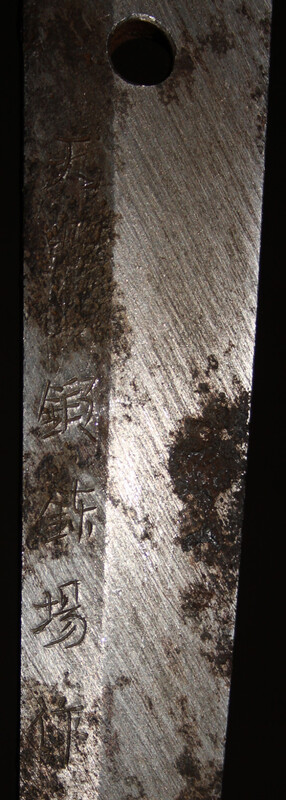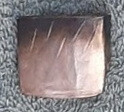-
Posts
2,753 -
Joined
-
Last visited
-
Days Won
27
Everything posted by Bazza
-
It is more likely to be lacquer, I think. I have seen lacquer on a tsuka that one would swear was leather... BaZZa.
-
I'm sure John has your best interests at heart Geoffrey!!! Honestly, if you put them up for sale there would be stampede!! I can't believe how lucky you are that NO ONE has 'restored' these in the best Western tradition of metal polish and scrubbing!! If you were ever captivated by Japanese art (like all the folk on this Board) your lucky find is the basis for a collecting career in Japanese tsuba (sword 'guards'). However, again like most folk on this Board the collecting of such is bound to keep you poor. Just ask me!!! Do please keep us all in touch with where you want to go - and welcome to the Board community. BaZZa. aka Barry Thomas (Melbourne, Australia)
-

Trying to identify maker Shin Gunto
Bazza replied to deadoscillate's topic in Military Swords of Japan
Oh, to have it in the hand!!! I would opine this is a WW2 era sword no question. The shape of the nakago and the patina easily suggest this (to me). The large shinobiana (the bottom hole in the nakago) is noteworthy and not seen (?) on Shintou or Shinshintou swords. The koshirae has 'blackened' fittings and others can comment on this. It has its tassel. Oh, and the kanji for SHIGEMITSU is well-struck and looks very elegant, not the scrappy signatures so often seen. The quality of the hamon is not easily seen, but selectively enlarging a portion of the blade pic shows what seems to me to be a komidare hamon - picture below that needs to be enlarged in a viewer. All-in-all I see this as a worthy and collectible sword, depending always on what one likes to collect and of course the price. I might suggest it is a good item to get, study and pass on much later if your collecting direction doesn't sit in the area of this sword. BaZZa. -
Brethren, Just stumbled across this site I haven't seen before: https://www.spoon-tamago.com/2020/02/05/eliza-scidmore-photographed-everyday-life-in-Japan-over-100-years-ago/?mc_cid=77cafa5ffb&mc_eid=962267c38c There are numerous 'by-way' tags of interest there too. Bestests, BaZZa.
- 1 reply
-
- 12
-

-
I'm sure I remember a gold-mounted tachi being offered for sale as belonging to the Duke of Windsor/Edward VIII. This was many years ago. It was apparently a gift to the Duke on a visit to Japan??? I don't remember the blade. BaZZa.
-
Gents, I believe the appearance is a property of the steel itself and its response to corrosion. Reason?? I have a TENSHOZAN sword with a near identical rust pattern with area of pristine steel. I believe Robin's sword was once like the one I have, but Robin's nakago has been cleaned. I think it is clear that if I cleaned my nakago it would show the same pattern of rust and pitting.The mei is executed in the same thin characters. I might add this sword is BIG and is in a Shingunto koshirae. BaZZa.
-

What are your viewpoints on using Nihonto?
Bazza replied to Misconstrued's topic in General Nihonto Related Discussion
NYET. NEIN, IE, plain old NO!! BaZZa. -
Ron, G'day. To me it looks more like a kanji than a kao. Waiting now for Morita san or Moriyama san to chip in. BaZZa.
-
Informal gatherings of like-minded people works for me. For really, really serious stuff one should join the NBTHK and go to the formal kantei sessions, or at the least a well-organised kantei by a 'local' collector who has done the hard yards. Sadly, that's too stratospheric for someone at my station in life, but it is the ideal aim of both scholarship and connoisseurship, to be sure. Me, I just enjoy collecting what I can and showing and discussing it and reading and being a part of NMB and the great knowledge some of our luminaries share with the rest of us , at least, those like me. BaZZa.
-
Well, I was going to keep out of this, but I must like the feeling of the block!! Or is it the dodan!!! Taking Soren's invitation to heart, I've looked at his tsuba a lot and thought about it, tossing and turning it around in my mind to try and do justice to it. I have looked at a lot of tsuba in my time including some I thought were masterworks, or at the least very, very good. FWIW, to me it doesn't 'sparkle' and the execution looks 'blocky' to my eye, but that may be just a lack of exposure to the right kind of knowledge and examples in the hand. Ford's approach is the same advice given about blades - judge the work, not the signature. Or in other words, the workmanship confirms the signature. Considering SteveM's expressions, this tsuba purporting to be a masterwork needs to go to Shinsa, but not before much study and thinking long and hard... BaZZa.
-
It does seem to be holding the gentleman upright!!!!! BaZZa.
-
A mate asked me to lunch a few days ago for my first visit to his house. Now, I know this bloke well. He has 4 rather nice swords that are above the batting average for a beginner. However, as he was showing me over his old, rambling house that was a once long ago haven for artists of various persuasions, we went down a flight of stairs to a large ground floor room that seemed hardly used apart from a Great Wall of Books. In the gloom on a mantle-piece I saw a kake with a sword on it immediately recognisable by its lack of a drag as a Type 95 I wasn't aware he owned. Having asked permission I picked it up and noticed THE BEST original copper handle I have ever seen. Totally unmolested and with a beautiful, bronze-like patina. No photo sorry as I wasn't prepared. However, I did note that the serial number was 4250. I shall remember it in case it ever becomes available. BaZZa.
-
G'day Dan, The 'kozuka' you refer to is actually called a kogatana (ko-katana - lit. a 'little sword'), while the decorative handle is the actual kozuka (ko-tsuka - lit. 'little handle'). The bent kogatana has very poorly incised characters that mean nothing at all, and in and of themselves suggest a non-Japanese blade. There are literally thousands of reproduction kogatana many from the Philippines and elsewhere and almost as many worthless, genuine antique items. If the wakizashi signature is not recorded, as Jacques says, it is called MEIKAN MORE -unknown smith. It is of course a quite genuine blade of about the mid-Edo period, plus or minus!! You may find a signature in an obscure Japanese language book. In short, a real, ridgy-didge sword of no great quality as these things go, but certainly a worthwhile collectible. BaZZa (Melbourne, Australia)
-
WOW!! My middle name happens to be 'DICK'. I loved the bits I 'loved' and only twigged further on that it was a 7-year old thread. I don't remember ever seeing it before, but a fantastically good read and catchup Piers. I do remember seeing a yari nakago jiri with an oblique cut - it was either this one or another one somewhere else. BaZZa.
-

When does collecting stop?
Bazza replied to Peter Bleed's topic in General Nihonto Related Discussion
Jeremiah wrote: > I know some folks with 100-300 swords. Never ends for them. I call these folk "Estates-in-Waiting"!! BaZZa. -
The fingerprints were free??? BaZZa.
-
So, where is the Demon??? He's always somewhere, even if obliquely. BaZZa.
-
I would on occasion wander into work with a colleague observing "You don't look your best Barry", to which I would reply "I've had an attack of empty bottle". BaZZa.
-
This thread will inevitably lead to discussion of gimei tameshimei. Gimei tameshimei are (I think, sample of two) hirazogan rather then inlaid in good calligraphy. Also later in the Edo period tameshimei were simply engraved like a regular mei and it is arguable how these can be verified as true. I used to collect tameshimei too and will add them here as I find them in my paper photocopy database. BaZZa.
-
The kissaki features uchizori, reverse curvature, surely hallmarking it as an utsushi. BaZZa.
-
Aaron, FWIW, the habaki looks as if it has been damaged previously, but at the same time the bluish tinge where it butts up to the tsuba suggests an oxidation colour of a couple hundred years more or less. This is a colour I have on some very old habaki of swords I have. It is an oxidation colour due to age and being near the scabbard opening and ought not be polished off. However, at the same time the habaki surface has a 'newish' look as if it has been polished within the last hundred years (i.e., since the end of WW2) and the silver has repatinated. BaZZa.
-
On the Nihonto Club website there is a smith: MAS17 Masaaki Higo Tensho (1573-1592) 肥後國松倉住日本一正明 higo kuni matsukura ju nihon ichi masaaki https://nihontoclub.com/view/smiths/meisearch?type=All&mei_op=contains&mei=matsukura BaZZa.
-

Top 10 Swordsmiths In Japanese History
Bazza replied to WillFalstaff's topic in General Nihonto Related Discussion
Of course, this is an endless discussion, though I enjoyed it immensely as our luminaries engaged their pens, and as I mentally ran through those swords I have been lucky enough to find in some 55 years searching in my own 'paddock', the highest ranked being TokuHo!! The thought that occurs to me is this - if I found such a work as Shugyosha posits, say o-suriage mumei katana and not in the best condition, would I recognise it for what it is???? Seeing the recently discovered Norishige in my own hands I'm more confident in saying yes, maybe. I then wonder what I might have missed along the way due to inexperience and lack of knowledge and condition in the blade and sold off to fund the next find out of the woodwork? Having pondered all this, I'm with the small fry, but wouldn't be interested in studying and collecting anything else, not for the World... My experience so far led me to recognise a bedraggled Shodai Sukehiro katana, an equally bedraggled possible Mutsu no Kami Tadayoshi wakizashi, and all this may yet be preparation for a forthcoming discovery - if I live long enough!! As John Yumoto once closed a letter to me more years ago than I care to remember 'Gambatte kudasai'. BaZZa. -

Top 10 Swordsmiths In Japanese History
Bazza replied to WillFalstaff's topic in General Nihonto Related Discussion
More so if one is aware of the depredations of some museums and their 'conservers'... BaZZa. -
As I recollect (from the Board somewhere. some time) the sword was by the Shinshintou smith Takahashi Naganobu?? BaZZa.








